Challenges and Recommendations in International Human Resource Management
VerifiedAdded on 2023/04/10
|15
|2937
|485
AI Summary
This report discusses the challenges faced in International Human Resource Management (IHRM) and provides recommendations to overcome them. It covers issues such as culture and communication, labor law conflicts, talent gap, and more. The report aims to help multinational companies effectively manage their global workforce.
Contribute Materials
Your contribution can guide someone’s learning journey. Share your
documents today.
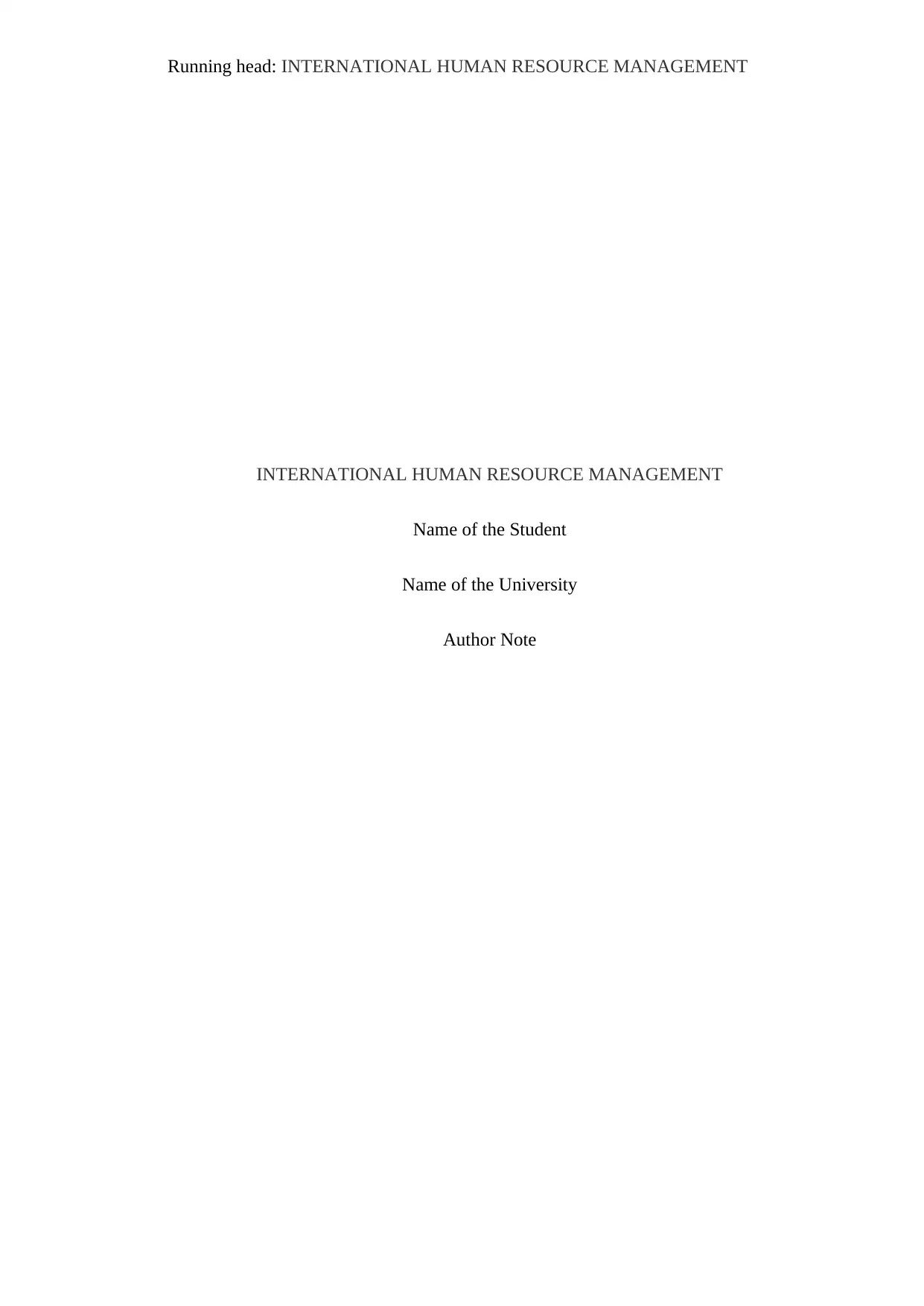
Running head: INTERNATIONAL HUMAN RESOURCE MANAGEMENT
INTERNATIONAL HUMAN RESOURCE MANAGEMENT
Name of the Student
Name of the University
Author Note
INTERNATIONAL HUMAN RESOURCE MANAGEMENT
Name of the Student
Name of the University
Author Note
Secure Best Marks with AI Grader
Need help grading? Try our AI Grader for instant feedback on your assignments.

1INTERNATIONAL HUMAN RESOURCE MANAGEMENT
Executive summary
International Human Resource Management is an organizational management functional
activities which aimed to manage the achieving goal of an organization at the international
level. On the other hand, IHRM functions to achieve all the objectives of an organization
such as the recruitment process, selection process, to give the training to the employees for
the development of company’s work, the appraisal of the performances, the dismal condition,
to manage the promotion of the employees and so on. In the day to day advancement of the
society, the technologies are also uplifting its position from its global landscape. For the
advancement of new technologies along with its global circle, the HR of the companies are
facing some challenges. The IHRM is responsible for the development of the management
techniques in most of the leading countries where different types of cultures, legal process,
and economic system exist. This report has described how the challenges of IHRM are
effective in the global landscape and how the HR manager will perform to face those
challenges. All the recommendations have also been described in this report so that
Multinational companies could easily achieve their targets oriented goals.
Executive summary
International Human Resource Management is an organizational management functional
activities which aimed to manage the achieving goal of an organization at the international
level. On the other hand, IHRM functions to achieve all the objectives of an organization
such as the recruitment process, selection process, to give the training to the employees for
the development of company’s work, the appraisal of the performances, the dismal condition,
to manage the promotion of the employees and so on. In the day to day advancement of the
society, the technologies are also uplifting its position from its global landscape. For the
advancement of new technologies along with its global circle, the HR of the companies are
facing some challenges. The IHRM is responsible for the development of the management
techniques in most of the leading countries where different types of cultures, legal process,
and economic system exist. This report has described how the challenges of IHRM are
effective in the global landscape and how the HR manager will perform to face those
challenges. All the recommendations have also been described in this report so that
Multinational companies could easily achieve their targets oriented goals.
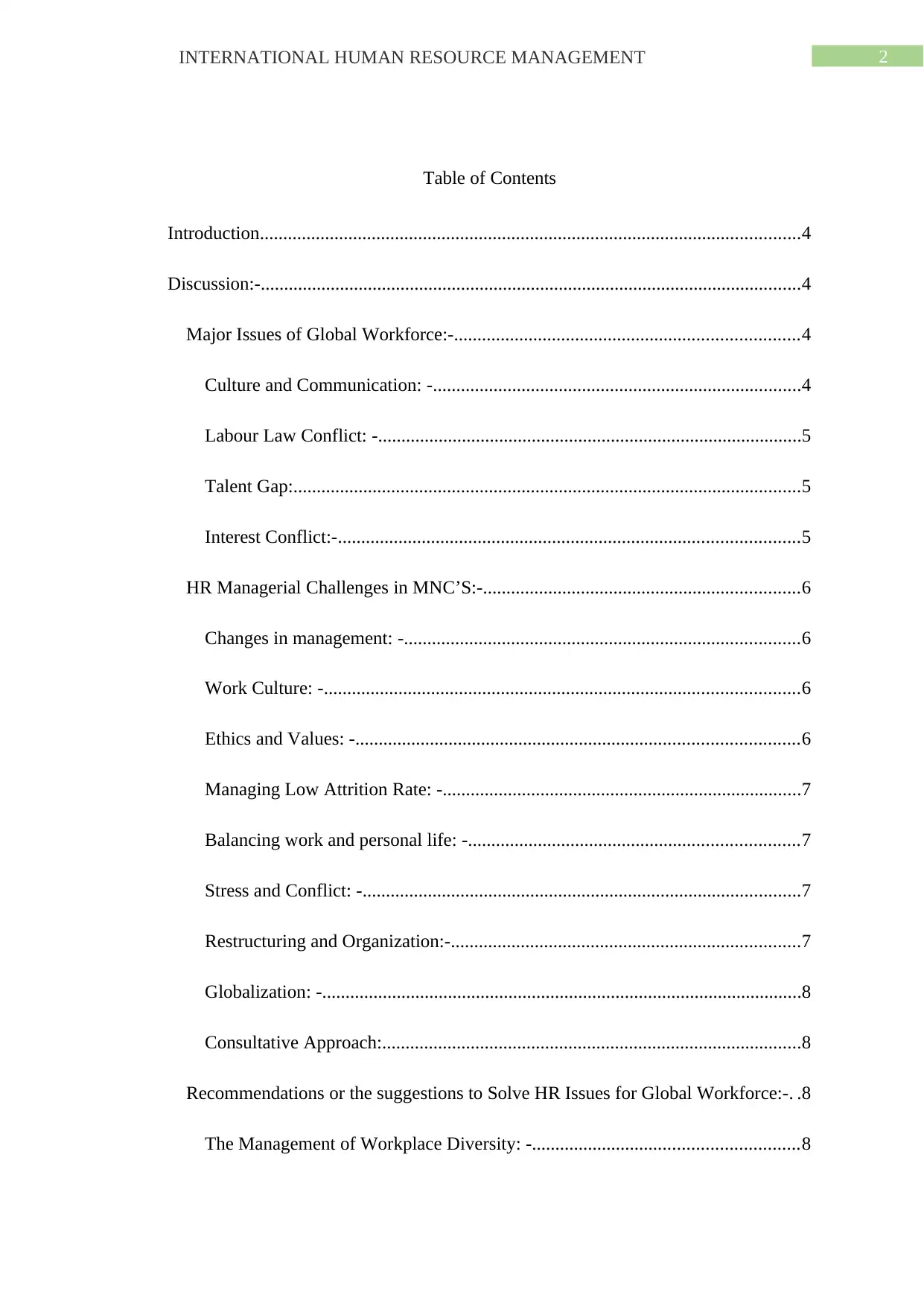
2INTERNATIONAL HUMAN RESOURCE MANAGEMENT
Table of Contents
Introduction....................................................................................................................4
Discussion:-....................................................................................................................4
Major Issues of Global Workforce:-..........................................................................4
Culture and Communication: -...............................................................................4
Labour Law Conflict: -...........................................................................................5
Talent Gap:.............................................................................................................5
Interest Conflict:-...................................................................................................5
HR Managerial Challenges in MNC’S:-....................................................................6
Changes in management: -.....................................................................................6
Work Culture: -......................................................................................................6
Ethics and Values: -...............................................................................................6
Managing Low Attrition Rate: -.............................................................................7
Balancing work and personal life: -.......................................................................7
Stress and Conflict: -..............................................................................................7
Restructuring and Organization:-...........................................................................7
Globalization: -.......................................................................................................8
Consultative Approach:..........................................................................................8
Recommendations or the suggestions to Solve HR Issues for Global Workforce:-. .8
The Management of Workplace Diversity: -.........................................................8
Table of Contents
Introduction....................................................................................................................4
Discussion:-....................................................................................................................4
Major Issues of Global Workforce:-..........................................................................4
Culture and Communication: -...............................................................................4
Labour Law Conflict: -...........................................................................................5
Talent Gap:.............................................................................................................5
Interest Conflict:-...................................................................................................5
HR Managerial Challenges in MNC’S:-....................................................................6
Changes in management: -.....................................................................................6
Work Culture: -......................................................................................................6
Ethics and Values: -...............................................................................................6
Managing Low Attrition Rate: -.............................................................................7
Balancing work and personal life: -.......................................................................7
Stress and Conflict: -..............................................................................................7
Restructuring and Organization:-...........................................................................7
Globalization: -.......................................................................................................8
Consultative Approach:..........................................................................................8
Recommendations or the suggestions to Solve HR Issues for Global Workforce:-. .8
The Management of Workplace Diversity: -.........................................................8
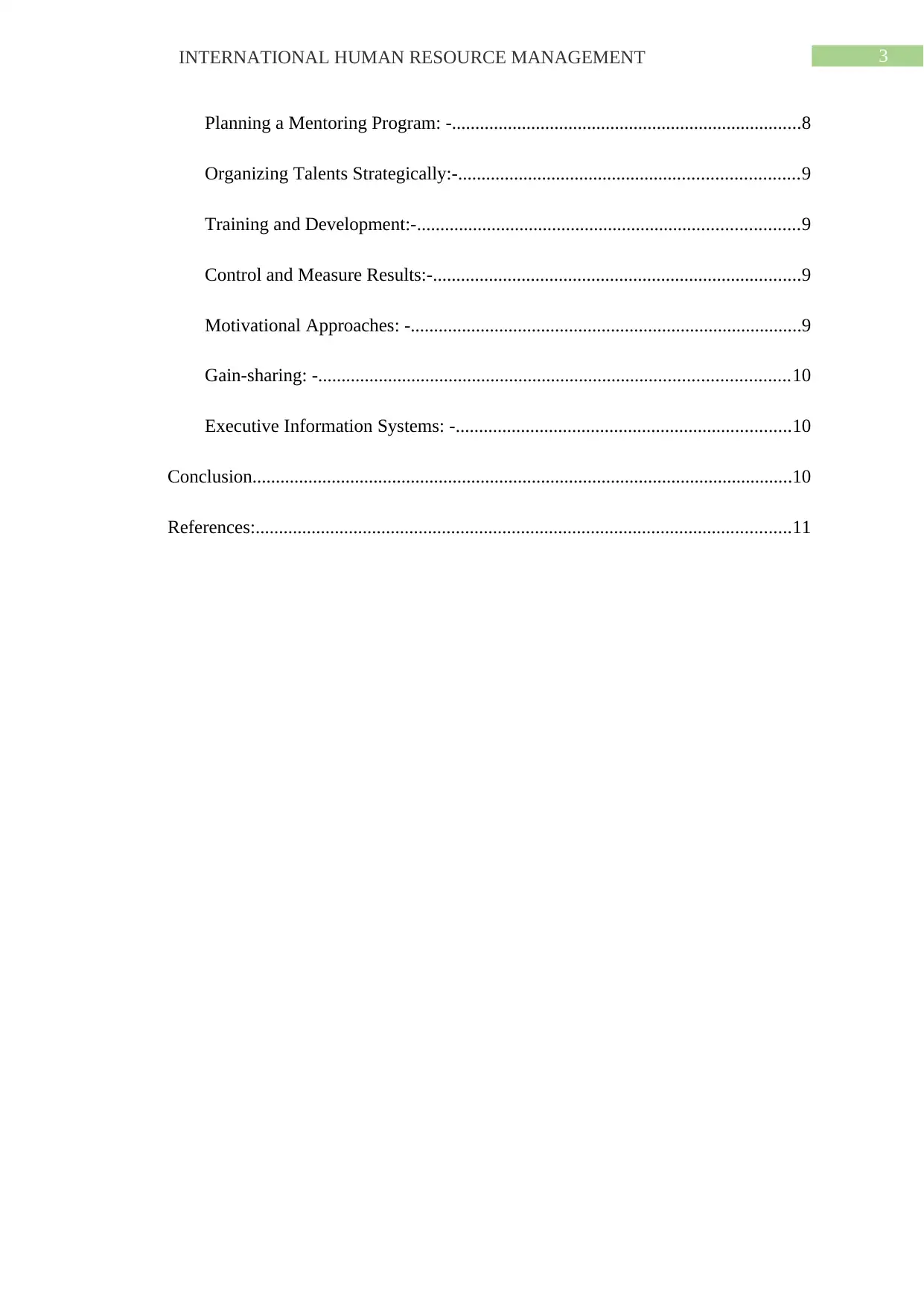
3INTERNATIONAL HUMAN RESOURCE MANAGEMENT
Planning a Mentoring Program: -...........................................................................8
Organizing Talents Strategically:-.........................................................................9
Training and Development:-..................................................................................9
Control and Measure Results:-...............................................................................9
Motivational Approaches: -....................................................................................9
Gain-sharing: -.....................................................................................................10
Executive Information Systems: -........................................................................10
Conclusion....................................................................................................................10
References:...................................................................................................................11
Planning a Mentoring Program: -...........................................................................8
Organizing Talents Strategically:-.........................................................................9
Training and Development:-..................................................................................9
Control and Measure Results:-...............................................................................9
Motivational Approaches: -....................................................................................9
Gain-sharing: -.....................................................................................................10
Executive Information Systems: -........................................................................10
Conclusion....................................................................................................................10
References:...................................................................................................................11
Secure Best Marks with AI Grader
Need help grading? Try our AI Grader for instant feedback on your assignments.

4INTERNATIONAL HUMAN RESOURCE MANAGEMENT
Introduction
International Human Resource Management (IHRM) is a set of management activities
which always concerns with recruitment, the process of training along with development, the
performance of the workers, give an appraisal, and mostly the communication with the labour
and maintain good relations with them (Budhwar., 2017). The primary need for a particular
type of HRM is to be determined by the need for the adaptation or standardization. Managing
human resources in world aspect is more complicated than in a domestic set up due to the
enormous differences between headquarters and the subsidiaries. This report will be focusing
on those challenging factors that are faced by the multinational companies HR department.
This report will be highlighting the major issues of the workforce such as the culture and
communication, labour law conflict, talent gap and so on. On the other hand, this report will
be discussing the recommendations to solve the issues (Deresky, 2017). The primary motive
of this report is to explain the statement working in a global landscape; multinational
organizations are faced with challenges that are related to human resource management.
Discussion:-
Major Issues of Global Workforce:-
Culture and Communication: -
While going to take someone from a particular environment into another, there must
be the changes can be seen in their culture and communication. This issue is basically the
diversifying effect of an individual from their workforce. The different organization has
different viewpoints, along with different customs (Farndale et al., 2017). This cultural and
communication issue in the global workplace is a multifaceted phenomenon which can be
seen among the members of the organization. Nowadays this diversity of the workforce
Introduction
International Human Resource Management (IHRM) is a set of management activities
which always concerns with recruitment, the process of training along with development, the
performance of the workers, give an appraisal, and mostly the communication with the labour
and maintain good relations with them (Budhwar., 2017). The primary need for a particular
type of HRM is to be determined by the need for the adaptation or standardization. Managing
human resources in world aspect is more complicated than in a domestic set up due to the
enormous differences between headquarters and the subsidiaries. This report will be focusing
on those challenging factors that are faced by the multinational companies HR department.
This report will be highlighting the major issues of the workforce such as the culture and
communication, labour law conflict, talent gap and so on. On the other hand, this report will
be discussing the recommendations to solve the issues (Deresky, 2017). The primary motive
of this report is to explain the statement working in a global landscape; multinational
organizations are faced with challenges that are related to human resource management.
Discussion:-
Major Issues of Global Workforce:-
Culture and Communication: -
While going to take someone from a particular environment into another, there must
be the changes can be seen in their culture and communication. This issue is basically the
diversifying effect of an individual from their workforce. The different organization has
different viewpoints, along with different customs (Farndale et al., 2017). This cultural and
communication issue in the global workplace is a multifaceted phenomenon which can be
seen among the members of the organization. Nowadays this diversity of the workforce

5INTERNATIONAL HUMAN RESOURCE MANAGEMENT
become a significant issue in IHRM, as it has some legal , moral as well as the business
implications for the organization.
Labour Law Conflict: -
The political issue is another major issue that is affected in IHRM, by its legal and
regulatory environment. One of the major issue that can be pointed out by giving an example:
“Employment at Will” statement in the US has stated that the company may terminate an
employee at any time without giving any cause or reason. This concept does not exist in
India and other countries (Gomes et al., 2015). The major issues of political environment
attached to the extension of external regulations, different types of labour legislation, the
nature of work contracts, different case law and so on. Some of the factors of political issues
are never changing. It is the responsibility of the HR to anticipate those changes along with to
implement such laws that are beneficial for the organization.
Talent management or skills gap:
The most challenging issue of the global market is the finding of talents for the high
profile jobs. Talent management in IHRM is a strategy which is applied by the HR manager
of the company to help and to promoting the business (Haak-Saheem et al., 2017). There are
some strategies or principles for the talent management which help the company to expand
their business in global market. Such principles of the global talent management by the HR
are: arrangement with the strategies, internal stability, mixing of culture in work force, the
participation in management, non-profitable job training for the employee.
Conflict in growth of interest:-
The successful markets across the borders are critical while going to talk about the
business (Itani et al., 2015). Conflict in global level can be observed by the people when
employees staying outside from their country. In the national level the work forces are
become a significant issue in IHRM, as it has some legal , moral as well as the business
implications for the organization.
Labour Law Conflict: -
The political issue is another major issue that is affected in IHRM, by its legal and
regulatory environment. One of the major issue that can be pointed out by giving an example:
“Employment at Will” statement in the US has stated that the company may terminate an
employee at any time without giving any cause or reason. This concept does not exist in
India and other countries (Gomes et al., 2015). The major issues of political environment
attached to the extension of external regulations, different types of labour legislation, the
nature of work contracts, different case law and so on. Some of the factors of political issues
are never changing. It is the responsibility of the HR to anticipate those changes along with to
implement such laws that are beneficial for the organization.
Talent management or skills gap:
The most challenging issue of the global market is the finding of talents for the high
profile jobs. Talent management in IHRM is a strategy which is applied by the HR manager
of the company to help and to promoting the business (Haak-Saheem et al., 2017). There are
some strategies or principles for the talent management which help the company to expand
their business in global market. Such principles of the global talent management by the HR
are: arrangement with the strategies, internal stability, mixing of culture in work force, the
participation in management, non-profitable job training for the employee.
Conflict in growth of interest:-
The successful markets across the borders are critical while going to talk about the
business (Itani et al., 2015). Conflict in global level can be observed by the people when
employees staying outside from their country. In the national level the work forces are
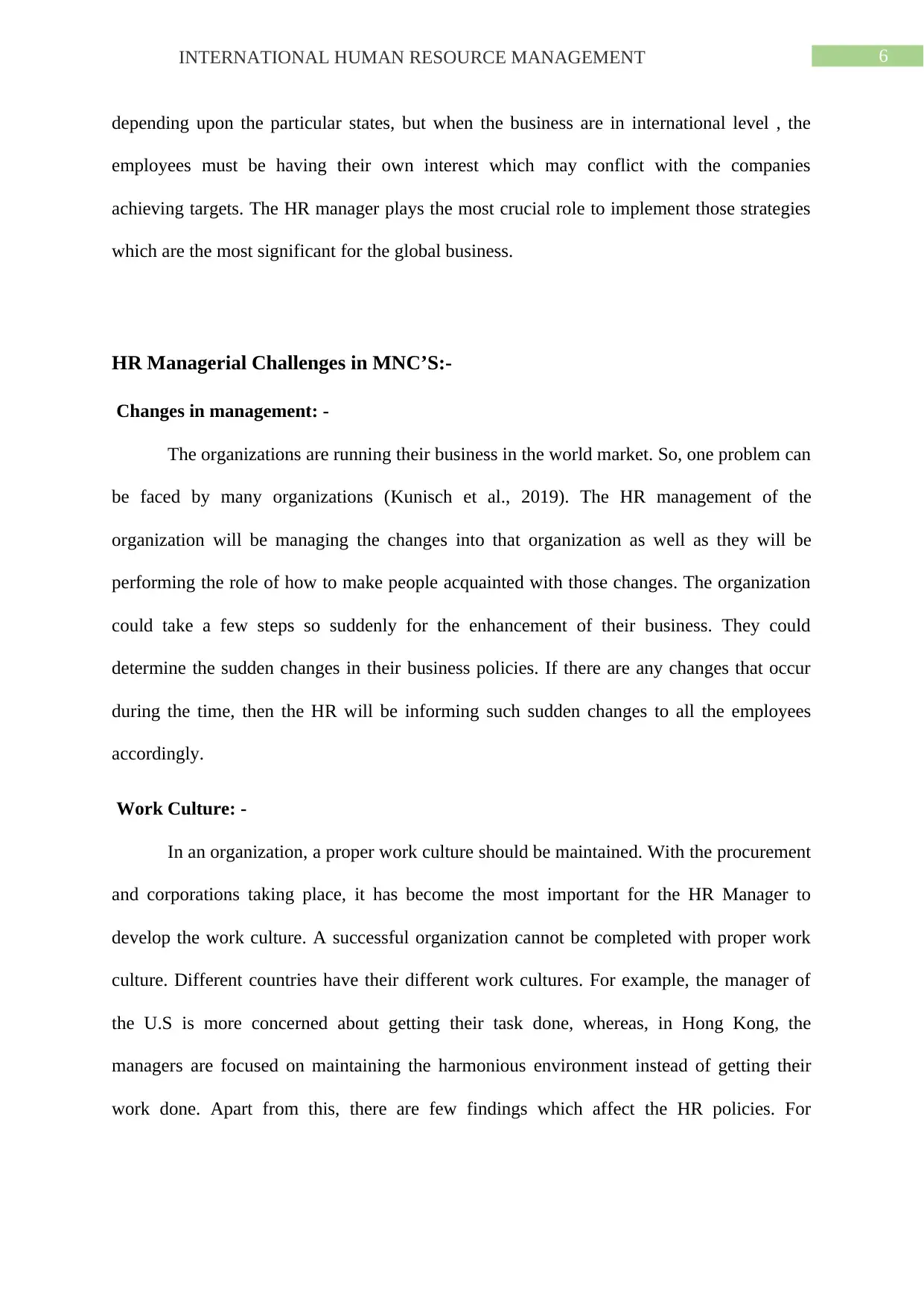
6INTERNATIONAL HUMAN RESOURCE MANAGEMENT
depending upon the particular states, but when the business are in international level , the
employees must be having their own interest which may conflict with the companies
achieving targets. The HR manager plays the most crucial role to implement those strategies
which are the most significant for the global business.
HR Managerial Challenges in MNC’S:-
Changes in management: -
The organizations are running their business in the world market. So, one problem can
be faced by many organizations (Kunisch et al., 2019). The HR management of the
organization will be managing the changes into that organization as well as they will be
performing the role of how to make people acquainted with those changes. The organization
could take a few steps so suddenly for the enhancement of their business. They could
determine the sudden changes in their business policies. If there are any changes that occur
during the time, then the HR will be informing such sudden changes to all the employees
accordingly.
Work Culture: -
In an organization, a proper work culture should be maintained. With the procurement
and corporations taking place, it has become the most important for the HR Manager to
develop the work culture. A successful organization cannot be completed with proper work
culture. Different countries have their different work cultures. For example, the manager of
the U.S is more concerned about getting their task done, whereas, in Hong Kong, the
managers are focused on maintaining the harmonious environment instead of getting their
work done. Apart from this, there are few findings which affect the HR policies. For
depending upon the particular states, but when the business are in international level , the
employees must be having their own interest which may conflict with the companies
achieving targets. The HR manager plays the most crucial role to implement those strategies
which are the most significant for the global business.
HR Managerial Challenges in MNC’S:-
Changes in management: -
The organizations are running their business in the world market. So, one problem can
be faced by many organizations (Kunisch et al., 2019). The HR management of the
organization will be managing the changes into that organization as well as they will be
performing the role of how to make people acquainted with those changes. The organization
could take a few steps so suddenly for the enhancement of their business. They could
determine the sudden changes in their business policies. If there are any changes that occur
during the time, then the HR will be informing such sudden changes to all the employees
accordingly.
Work Culture: -
In an organization, a proper work culture should be maintained. With the procurement
and corporations taking place, it has become the most important for the HR Manager to
develop the work culture. A successful organization cannot be completed with proper work
culture. Different countries have their different work cultures. For example, the manager of
the U.S is more concerned about getting their task done, whereas, in Hong Kong, the
managers are focused on maintaining the harmonious environment instead of getting their
work done. Apart from this, there are few findings which affect the HR policies. For
Paraphrase This Document
Need a fresh take? Get an instant paraphrase of this document with our AI Paraphraser

7INTERNATIONAL HUMAN RESOURCE MANAGEMENT
example, in Mexico, the employees expect from their manager to keep distance rather than to
be closer. In the USA this method is not applicable as the managers and workers
Ethics and Values: -
In every organization, the ethics along with the moral values are very essential part
for the business. The existence of the global organization face a challenge regarding the issue
of ethics along with the values. The contradiction regarding this issue is depending upon the
particular culture as well as beliefs. The organization cannot apply their own ethics or values
everywhere. It is the responsibility of the HR manager to provide the training to the
employees to make them aware about the corruption methods, the handling of situation while
any problematic situation arise. The HR manager also can implement the performance levels
to give support towards the reduction of all the corruptions.
Managing Slow destruction Rate: -
Additional competition correspondingly adds to the gradual reduction. The function
of the HR manager is to play a crucial role to manage low attrition and introduce good
retention strategies for the development of the company. If there is any political or legal
changes arise regarding the low-attrition rate, then almost all the HR managers will be
affected by the regulatory environment. The HR manager is always responsible for looking
after that low-attrition rate.
Balancing work and personal life: -
In every organization, mostly in the global landscape, a proper balance should be
maintained between the workforce and the personal life of the employees. This is the most
important responsibility of the HR manager to create a balance between the work life and
personal life by providing the flexible work hours, paternity leaves and vocations are some of
the options hand.
example, in Mexico, the employees expect from their manager to keep distance rather than to
be closer. In the USA this method is not applicable as the managers and workers
Ethics and Values: -
In every organization, the ethics along with the moral values are very essential part
for the business. The existence of the global organization face a challenge regarding the issue
of ethics along with the values. The contradiction regarding this issue is depending upon the
particular culture as well as beliefs. The organization cannot apply their own ethics or values
everywhere. It is the responsibility of the HR manager to provide the training to the
employees to make them aware about the corruption methods, the handling of situation while
any problematic situation arise. The HR manager also can implement the performance levels
to give support towards the reduction of all the corruptions.
Managing Slow destruction Rate: -
Additional competition correspondingly adds to the gradual reduction. The function
of the HR manager is to play a crucial role to manage low attrition and introduce good
retention strategies for the development of the company. If there is any political or legal
changes arise regarding the low-attrition rate, then almost all the HR managers will be
affected by the regulatory environment. The HR manager is always responsible for looking
after that low-attrition rate.
Balancing work and personal life: -
In every organization, mostly in the global landscape, a proper balance should be
maintained between the workforce and the personal life of the employees. This is the most
important responsibility of the HR manager to create a balance between the work life and
personal life by providing the flexible work hours, paternity leaves and vocations are some of
the options hand.
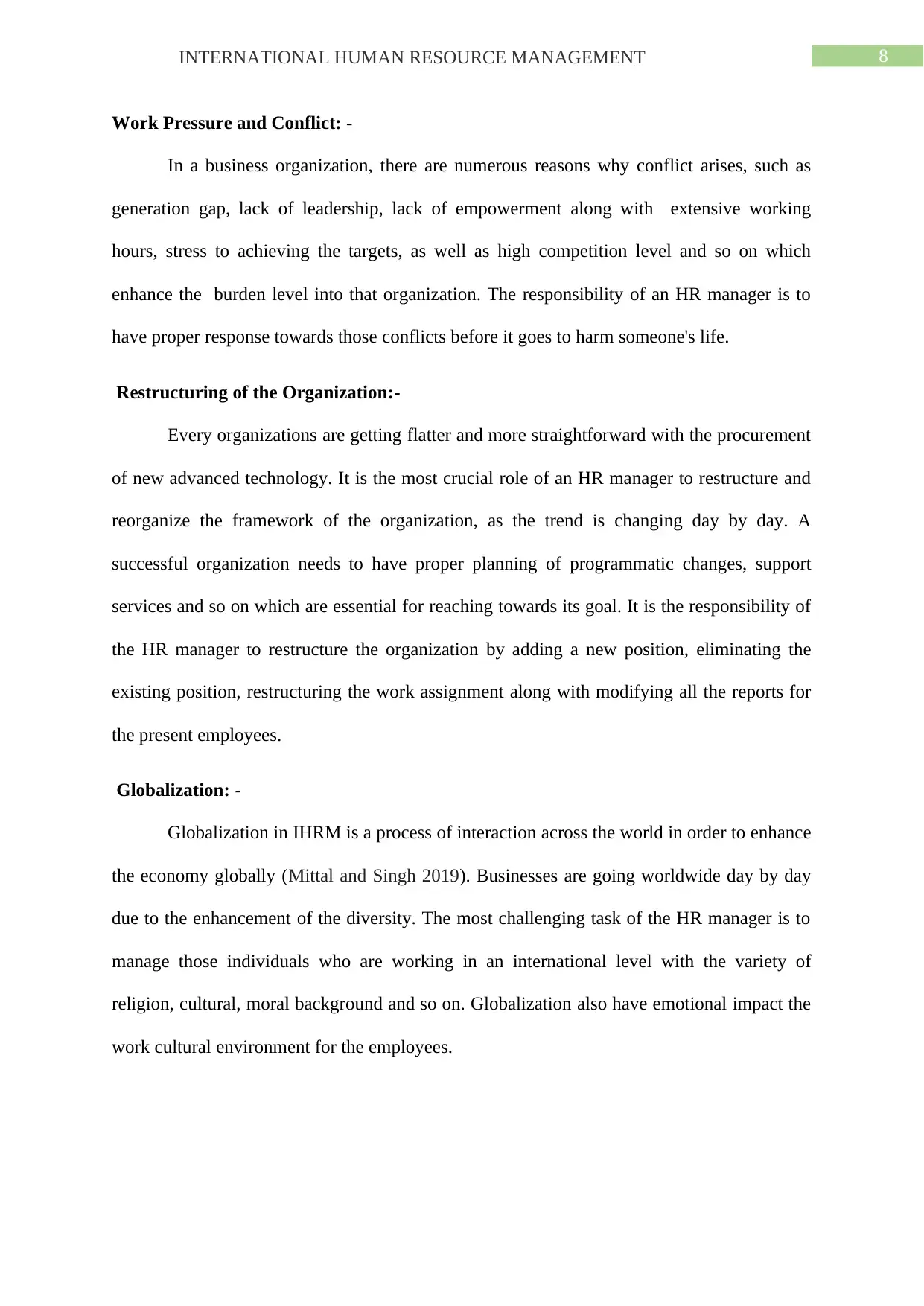
8INTERNATIONAL HUMAN RESOURCE MANAGEMENT
Work Pressure and Conflict: -
In a business organization, there are numerous reasons why conflict arises, such as
generation gap, lack of leadership, lack of empowerment along with extensive working
hours, stress to achieving the targets, as well as high competition level and so on which
enhance the burden level into that organization. The responsibility of an HR manager is to
have proper response towards those conflicts before it goes to harm someone's life.
Restructuring of the Organization:-
Every organizations are getting flatter and more straightforward with the procurement
of new advanced technology. It is the most crucial role of an HR manager to restructure and
reorganize the framework of the organization, as the trend is changing day by day. A
successful organization needs to have proper planning of programmatic changes, support
services and so on which are essential for reaching towards its goal. It is the responsibility of
the HR manager to restructure the organization by adding a new position, eliminating the
existing position, restructuring the work assignment along with modifying all the reports for
the present employees.
Globalization: -
Globalization in IHRM is a process of interaction across the world in order to enhance
the economy globally (Mittal and Singh 2019). Businesses are going worldwide day by day
due to the enhancement of the diversity. The most challenging task of the HR manager is to
manage those individuals who are working in an international level with the variety of
religion, cultural, moral background and so on. Globalization also have emotional impact the
work cultural environment for the employees.
Work Pressure and Conflict: -
In a business organization, there are numerous reasons why conflict arises, such as
generation gap, lack of leadership, lack of empowerment along with extensive working
hours, stress to achieving the targets, as well as high competition level and so on which
enhance the burden level into that organization. The responsibility of an HR manager is to
have proper response towards those conflicts before it goes to harm someone's life.
Restructuring of the Organization:-
Every organizations are getting flatter and more straightforward with the procurement
of new advanced technology. It is the most crucial role of an HR manager to restructure and
reorganize the framework of the organization, as the trend is changing day by day. A
successful organization needs to have proper planning of programmatic changes, support
services and so on which are essential for reaching towards its goal. It is the responsibility of
the HR manager to restructure the organization by adding a new position, eliminating the
existing position, restructuring the work assignment along with modifying all the reports for
the present employees.
Globalization: -
Globalization in IHRM is a process of interaction across the world in order to enhance
the economy globally (Mittal and Singh 2019). Businesses are going worldwide day by day
due to the enhancement of the diversity. The most challenging task of the HR manager is to
manage those individuals who are working in an international level with the variety of
religion, cultural, moral background and so on. Globalization also have emotional impact the
work cultural environment for the employees.
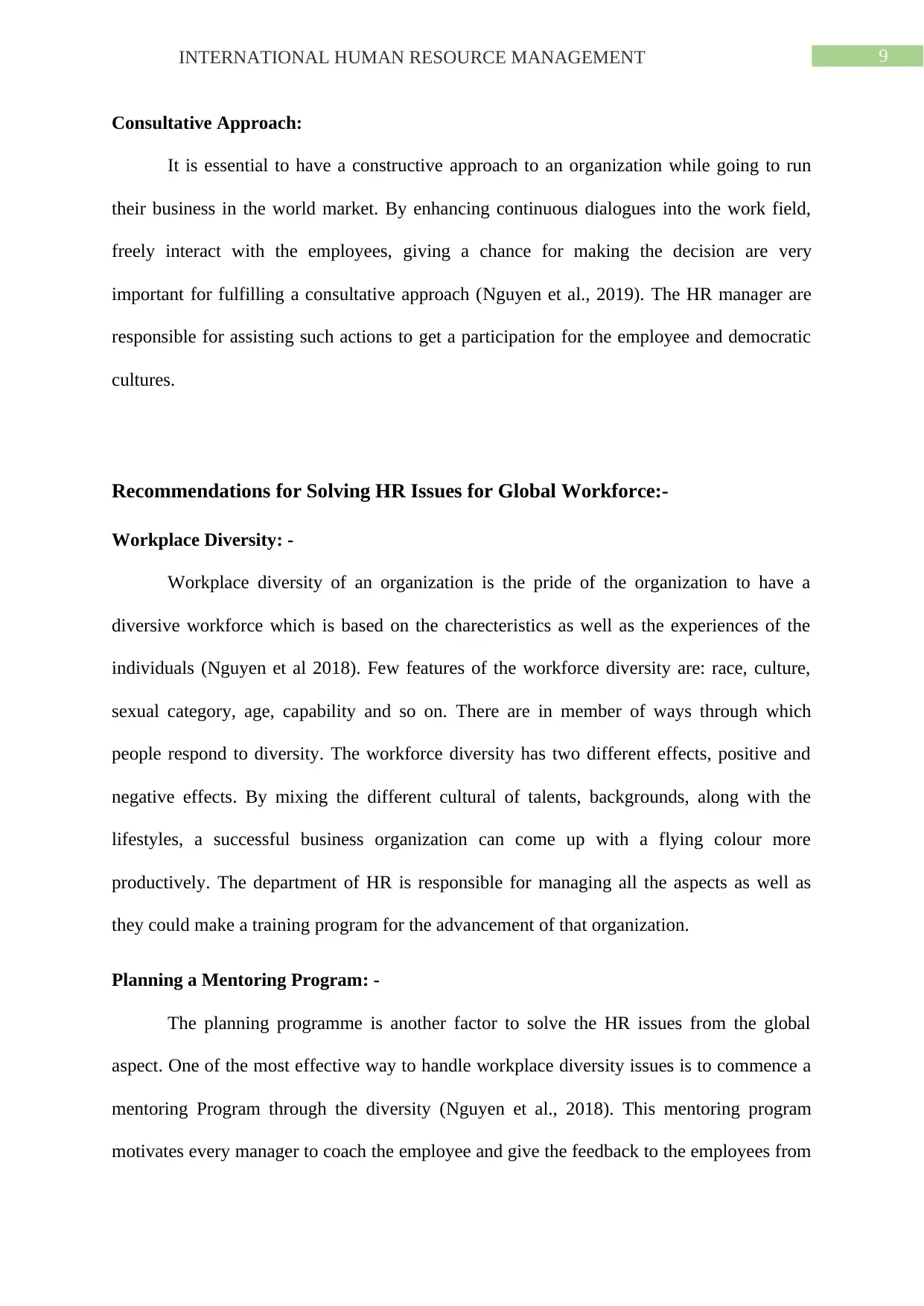
9INTERNATIONAL HUMAN RESOURCE MANAGEMENT
Consultative Approach:
It is essential to have a constructive approach to an organization while going to run
their business in the world market. By enhancing continuous dialogues into the work field,
freely interact with the employees, giving a chance for making the decision are very
important for fulfilling a consultative approach (Nguyen et al., 2019). The HR manager are
responsible for assisting such actions to get a participation for the employee and democratic
cultures.
Recommendations for Solving HR Issues for Global Workforce:-
Workplace Diversity: -
Workplace diversity of an organization is the pride of the organization to have a
diversive workforce which is based on the charecteristics as well as the experiences of the
individuals (Nguyen et al 2018). Few features of the workforce diversity are: race, culture,
sexual category, age, capability and so on. There are in member of ways through which
people respond to diversity. The workforce diversity has two different effects, positive and
negative effects. By mixing the different cultural of talents, backgrounds, along with the
lifestyles, a successful business organization can come up with a flying colour more
productively. The department of HR is responsible for managing all the aspects as well as
they could make a training program for the advancement of that organization.
Planning a Mentoring Program: -
The planning programme is another factor to solve the HR issues from the global
aspect. One of the most effective way to handle workplace diversity issues is to commence a
mentoring Program through the diversity (Nguyen et al., 2018). This mentoring program
motivates every manager to coach the employee and give the feedback to the employees from
Consultative Approach:
It is essential to have a constructive approach to an organization while going to run
their business in the world market. By enhancing continuous dialogues into the work field,
freely interact with the employees, giving a chance for making the decision are very
important for fulfilling a consultative approach (Nguyen et al., 2019). The HR manager are
responsible for assisting such actions to get a participation for the employee and democratic
cultures.
Recommendations for Solving HR Issues for Global Workforce:-
Workplace Diversity: -
Workplace diversity of an organization is the pride of the organization to have a
diversive workforce which is based on the charecteristics as well as the experiences of the
individuals (Nguyen et al 2018). Few features of the workforce diversity are: race, culture,
sexual category, age, capability and so on. There are in member of ways through which
people respond to diversity. The workforce diversity has two different effects, positive and
negative effects. By mixing the different cultural of talents, backgrounds, along with the
lifestyles, a successful business organization can come up with a flying colour more
productively. The department of HR is responsible for managing all the aspects as well as
they could make a training program for the advancement of that organization.
Planning a Mentoring Program: -
The planning programme is another factor to solve the HR issues from the global
aspect. One of the most effective way to handle workplace diversity issues is to commence a
mentoring Program through the diversity (Nguyen et al., 2018). This mentoring program
motivates every manager to coach the employee and give the feedback to the employees from
Secure Best Marks with AI Grader
Need help grading? Try our AI Grader for instant feedback on your assignments.
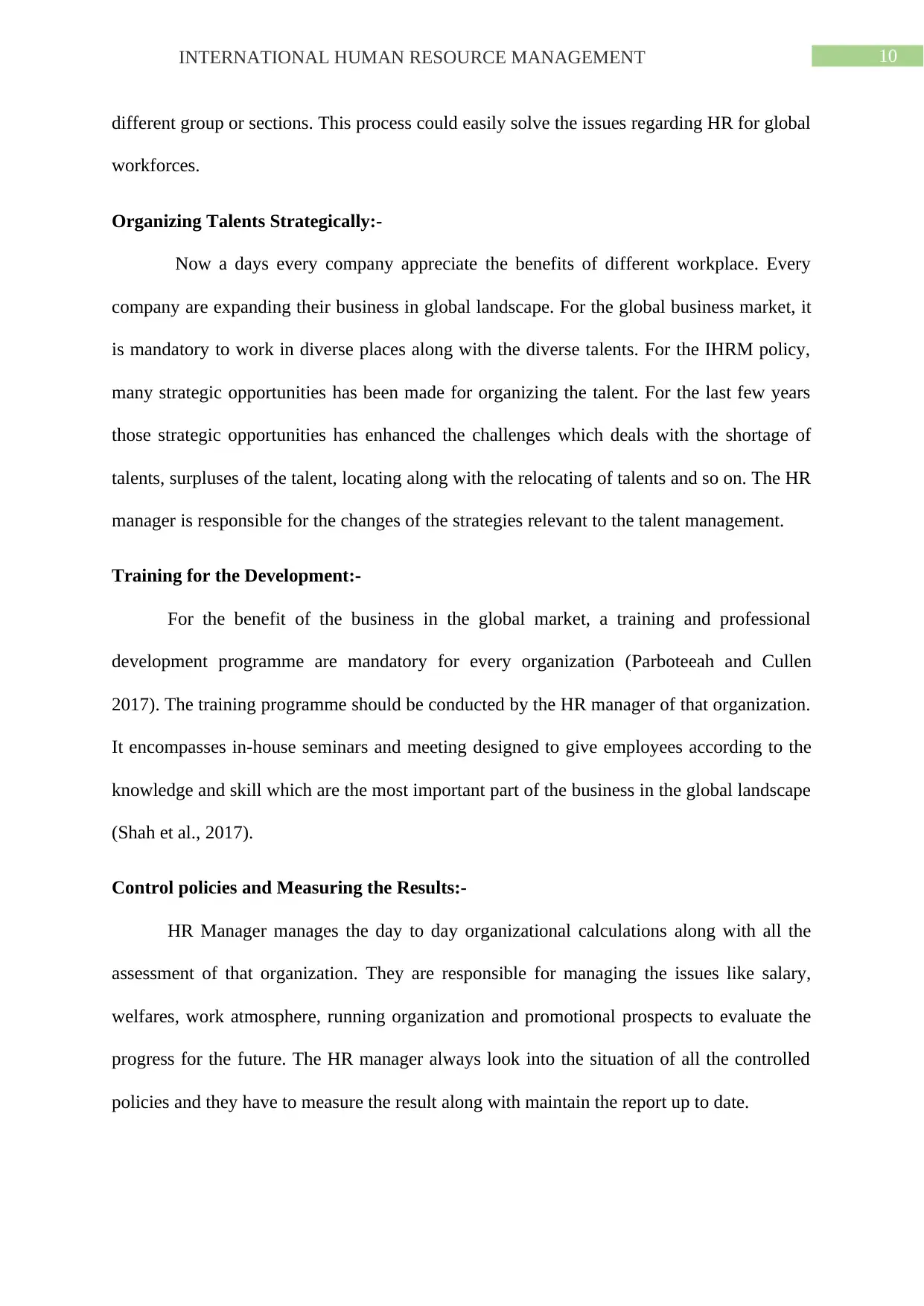
10INTERNATIONAL HUMAN RESOURCE MANAGEMENT
different group or sections. This process could easily solve the issues regarding HR for global
workforces.
Organizing Talents Strategically:-
Now a days every company appreciate the benefits of different workplace. Every
company are expanding their business in global landscape. For the global business market, it
is mandatory to work in diverse places along with the diverse talents. For the IHRM policy,
many strategic opportunities has been made for organizing the talent. For the last few years
those strategic opportunities has enhanced the challenges which deals with the shortage of
talents, surpluses of the talent, locating along with the relocating of talents and so on. The HR
manager is responsible for the changes of the strategies relevant to the talent management.
Training for the Development:-
For the benefit of the business in the global market, a training and professional
development programme are mandatory for every organization (Parboteeah and Cullen
2017). The training programme should be conducted by the HR manager of that organization.
It encompasses in-house seminars and meeting designed to give employees according to the
knowledge and skill which are the most important part of the business in the global landscape
(Shah et al., 2017).
Control policies and Measuring the Results:-
HR Manager manages the day to day organizational calculations along with all the
assessment of that organization. They are responsible for managing the issues like salary,
welfares, work atmosphere, running organization and promotional prospects to evaluate the
progress for the future. The HR manager always look into the situation of all the controlled
policies and they have to measure the result along with maintain the report up to date.
different group or sections. This process could easily solve the issues regarding HR for global
workforces.
Organizing Talents Strategically:-
Now a days every company appreciate the benefits of different workplace. Every
company are expanding their business in global landscape. For the global business market, it
is mandatory to work in diverse places along with the diverse talents. For the IHRM policy,
many strategic opportunities has been made for organizing the talent. For the last few years
those strategic opportunities has enhanced the challenges which deals with the shortage of
talents, surpluses of the talent, locating along with the relocating of talents and so on. The HR
manager is responsible for the changes of the strategies relevant to the talent management.
Training for the Development:-
For the benefit of the business in the global market, a training and professional
development programme are mandatory for every organization (Parboteeah and Cullen
2017). The training programme should be conducted by the HR manager of that organization.
It encompasses in-house seminars and meeting designed to give employees according to the
knowledge and skill which are the most important part of the business in the global landscape
(Shah et al., 2017).
Control policies and Measuring the Results:-
HR Manager manages the day to day organizational calculations along with all the
assessment of that organization. They are responsible for managing the issues like salary,
welfares, work atmosphere, running organization and promotional prospects to evaluate the
progress for the future. The HR manager always look into the situation of all the controlled
policies and they have to measure the result along with maintain the report up to date.
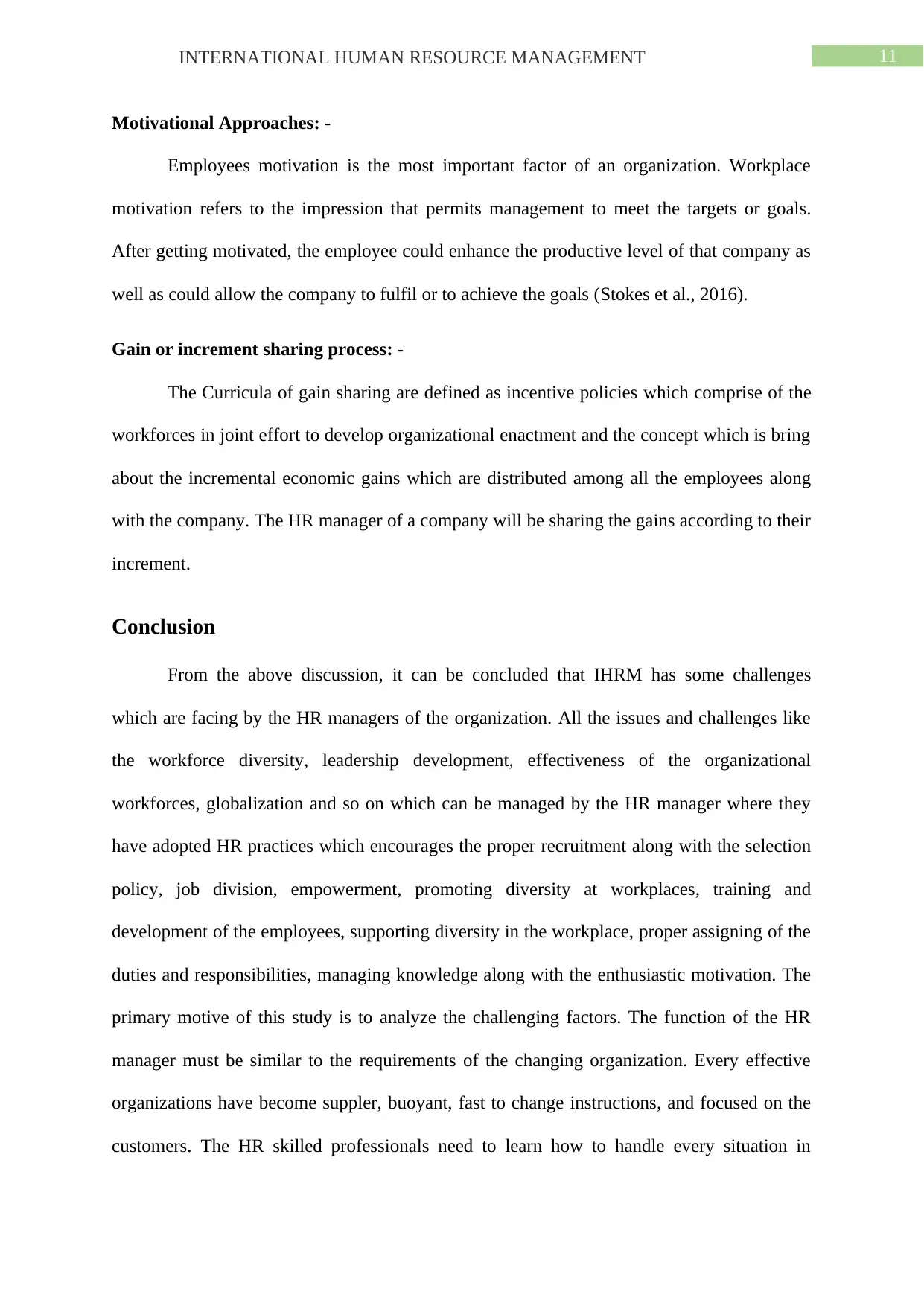
11INTERNATIONAL HUMAN RESOURCE MANAGEMENT
Motivational Approaches: -
Employees motivation is the most important factor of an organization. Workplace
motivation refers to the impression that permits management to meet the targets or goals.
After getting motivated, the employee could enhance the productive level of that company as
well as could allow the company to fulfil or to achieve the goals (Stokes et al., 2016).
Gain or increment sharing process: -
The Curricula of gain sharing are defined as incentive policies which comprise of the
workforces in joint effort to develop organizational enactment and the concept which is bring
about the incremental economic gains which are distributed among all the employees along
with the company. The HR manager of a company will be sharing the gains according to their
increment.
Conclusion
From the above discussion, it can be concluded that IHRM has some challenges
which are facing by the HR managers of the organization. All the issues and challenges like
the workforce diversity, leadership development, effectiveness of the organizational
workforces, globalization and so on which can be managed by the HR manager where they
have adopted HR practices which encourages the proper recruitment along with the selection
policy, job division, empowerment, promoting diversity at workplaces, training and
development of the employees, supporting diversity in the workplace, proper assigning of the
duties and responsibilities, managing knowledge along with the enthusiastic motivation. The
primary motive of this study is to analyze the challenging factors. The function of the HR
manager must be similar to the requirements of the changing organization. Every effective
organizations have become suppler, buoyant, fast to change instructions, and focused on the
customers. The HR skilled professionals need to learn how to handle every situation in
Motivational Approaches: -
Employees motivation is the most important factor of an organization. Workplace
motivation refers to the impression that permits management to meet the targets or goals.
After getting motivated, the employee could enhance the productive level of that company as
well as could allow the company to fulfil or to achieve the goals (Stokes et al., 2016).
Gain or increment sharing process: -
The Curricula of gain sharing are defined as incentive policies which comprise of the
workforces in joint effort to develop organizational enactment and the concept which is bring
about the incremental economic gains which are distributed among all the employees along
with the company. The HR manager of a company will be sharing the gains according to their
increment.
Conclusion
From the above discussion, it can be concluded that IHRM has some challenges
which are facing by the HR managers of the organization. All the issues and challenges like
the workforce diversity, leadership development, effectiveness of the organizational
workforces, globalization and so on which can be managed by the HR manager where they
have adopted HR practices which encourages the proper recruitment along with the selection
policy, job division, empowerment, promoting diversity at workplaces, training and
development of the employees, supporting diversity in the workplace, proper assigning of the
duties and responsibilities, managing knowledge along with the enthusiastic motivation. The
primary motive of this study is to analyze the challenging factors. The function of the HR
manager must be similar to the requirements of the changing organization. Every effective
organizations have become suppler, buoyant, fast to change instructions, and focused on the
customers. The HR skilled professionals need to learn how to handle every situation in

12INTERNATIONAL HUMAN RESOURCE MANAGEMENT
successful manner through forecasting, forming, shaping, leading as well as monitoring the
international human resource management.
successful manner through forecasting, forming, shaping, leading as well as monitoring the
international human resource management.
Paraphrase This Document
Need a fresh take? Get an instant paraphrase of this document with our AI Paraphraser
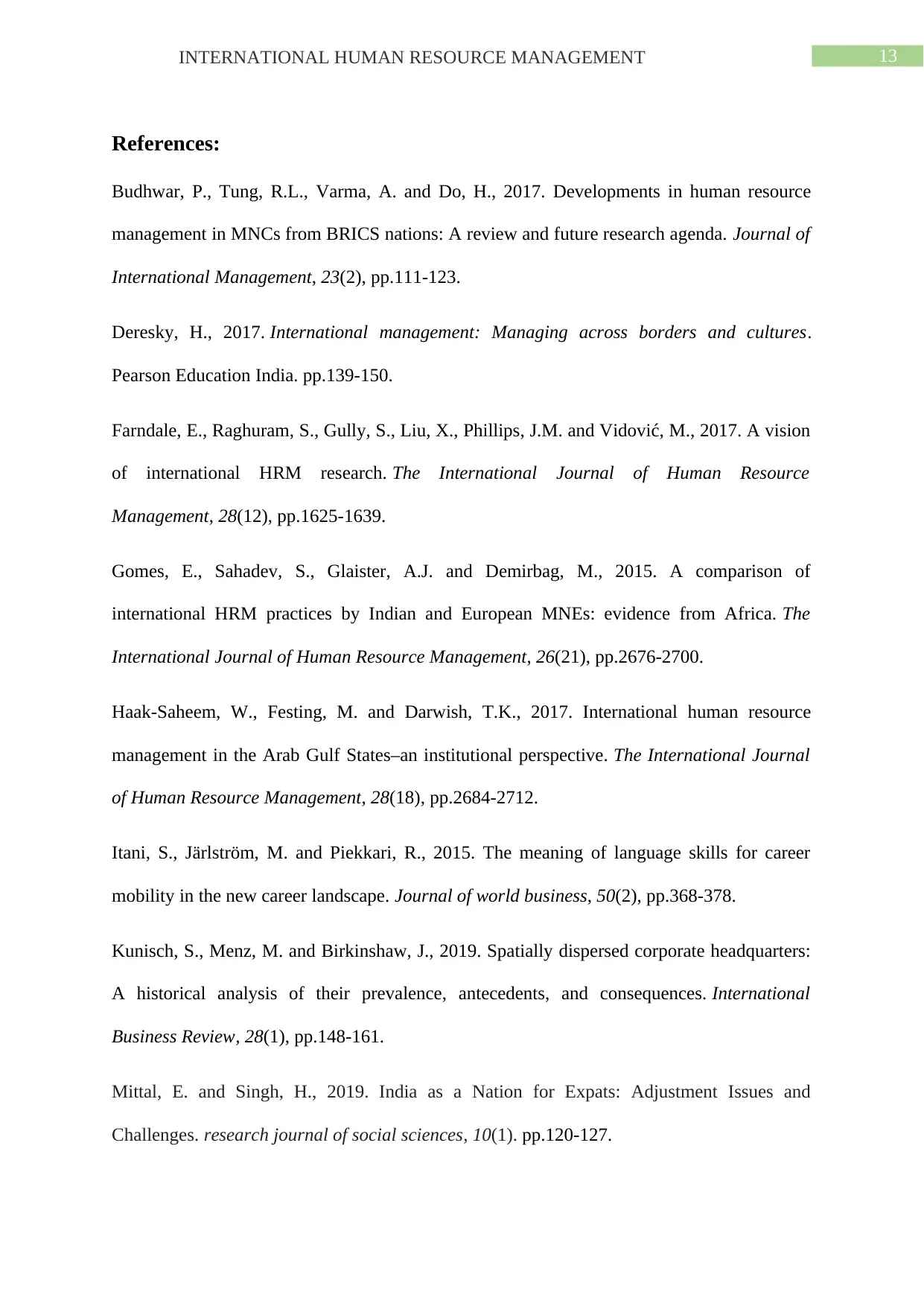
13INTERNATIONAL HUMAN RESOURCE MANAGEMENT
References:
Budhwar, P., Tung, R.L., Varma, A. and Do, H., 2017. Developments in human resource
management in MNCs from BRICS nations: A review and future research agenda. Journal of
International Management, 23(2), pp.111-123.
Deresky, H., 2017. International management: Managing across borders and cultures.
Pearson Education India. pp.139-150.
Farndale, E., Raghuram, S., Gully, S., Liu, X., Phillips, J.M. and Vidović, M., 2017. A vision
of international HRM research. The International Journal of Human Resource
Management, 28(12), pp.1625-1639.
Gomes, E., Sahadev, S., Glaister, A.J. and Demirbag, M., 2015. A comparison of
international HRM practices by Indian and European MNEs: evidence from Africa. The
International Journal of Human Resource Management, 26(21), pp.2676-2700.
Haak-Saheem, W., Festing, M. and Darwish, T.K., 2017. International human resource
management in the Arab Gulf States–an institutional perspective. The International Journal
of Human Resource Management, 28(18), pp.2684-2712.
Itani, S., Järlström, M. and Piekkari, R., 2015. The meaning of language skills for career
mobility in the new career landscape. Journal of world business, 50(2), pp.368-378.
Kunisch, S., Menz, M. and Birkinshaw, J., 2019. Spatially dispersed corporate headquarters:
A historical analysis of their prevalence, antecedents, and consequences. International
Business Review, 28(1), pp.148-161.
Mittal, E. and Singh, H., 2019. India as a Nation for Expats: Adjustment Issues and
Challenges. research journal of social sciences, 10(1). pp.120-127.
References:
Budhwar, P., Tung, R.L., Varma, A. and Do, H., 2017. Developments in human resource
management in MNCs from BRICS nations: A review and future research agenda. Journal of
International Management, 23(2), pp.111-123.
Deresky, H., 2017. International management: Managing across borders and cultures.
Pearson Education India. pp.139-150.
Farndale, E., Raghuram, S., Gully, S., Liu, X., Phillips, J.M. and Vidović, M., 2017. A vision
of international HRM research. The International Journal of Human Resource
Management, 28(12), pp.1625-1639.
Gomes, E., Sahadev, S., Glaister, A.J. and Demirbag, M., 2015. A comparison of
international HRM practices by Indian and European MNEs: evidence from Africa. The
International Journal of Human Resource Management, 26(21), pp.2676-2700.
Haak-Saheem, W., Festing, M. and Darwish, T.K., 2017. International human resource
management in the Arab Gulf States–an institutional perspective. The International Journal
of Human Resource Management, 28(18), pp.2684-2712.
Itani, S., Järlström, M. and Piekkari, R., 2015. The meaning of language skills for career
mobility in the new career landscape. Journal of world business, 50(2), pp.368-378.
Kunisch, S., Menz, M. and Birkinshaw, J., 2019. Spatially dispersed corporate headquarters:
A historical analysis of their prevalence, antecedents, and consequences. International
Business Review, 28(1), pp.148-161.
Mittal, E. and Singh, H., 2019. India as a Nation for Expats: Adjustment Issues and
Challenges. research journal of social sciences, 10(1). pp.120-127.
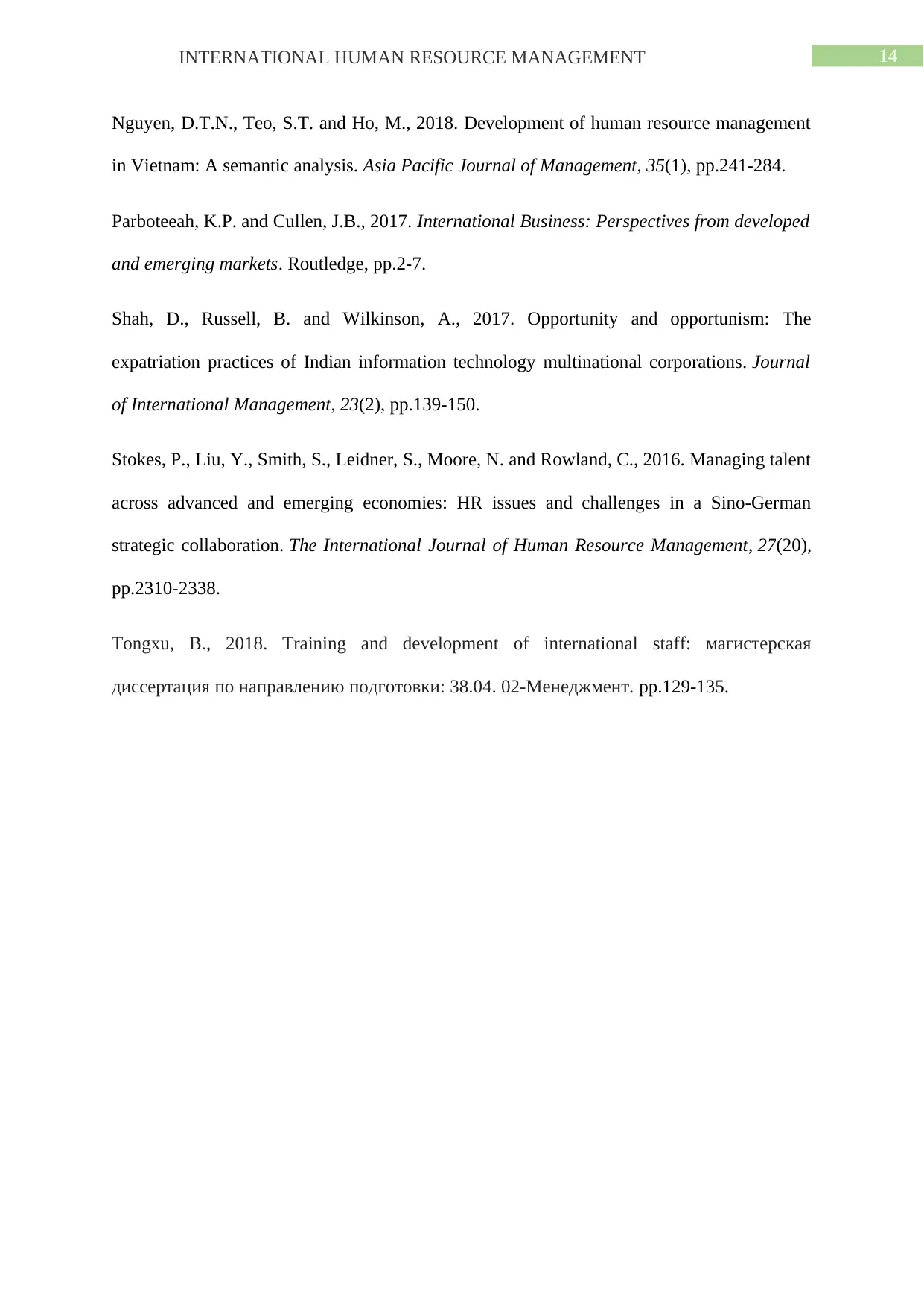
14INTERNATIONAL HUMAN RESOURCE MANAGEMENT
Nguyen, D.T.N., Teo, S.T. and Ho, M., 2018. Development of human resource management
in Vietnam: A semantic analysis. Asia Pacific Journal of Management, 35(1), pp.241-284.
Parboteeah, K.P. and Cullen, J.B., 2017. International Business: Perspectives from developed
and emerging markets. Routledge, pp.2-7.
Shah, D., Russell, B. and Wilkinson, A., 2017. Opportunity and opportunism: The
expatriation practices of Indian information technology multinational corporations. Journal
of International Management, 23(2), pp.139-150.
Stokes, P., Liu, Y., Smith, S., Leidner, S., Moore, N. and Rowland, C., 2016. Managing talent
across advanced and emerging economies: HR issues and challenges in a Sino-German
strategic collaboration. The International Journal of Human Resource Management, 27(20),
pp.2310-2338.
Tongxu, B., 2018. Training and development of international staff: магистерская
диссертация по направлению подготовки: 38.04. 02-Менеджмент. pp.129-135.
Nguyen, D.T.N., Teo, S.T. and Ho, M., 2018. Development of human resource management
in Vietnam: A semantic analysis. Asia Pacific Journal of Management, 35(1), pp.241-284.
Parboteeah, K.P. and Cullen, J.B., 2017. International Business: Perspectives from developed
and emerging markets. Routledge, pp.2-7.
Shah, D., Russell, B. and Wilkinson, A., 2017. Opportunity and opportunism: The
expatriation practices of Indian information technology multinational corporations. Journal
of International Management, 23(2), pp.139-150.
Stokes, P., Liu, Y., Smith, S., Leidner, S., Moore, N. and Rowland, C., 2016. Managing talent
across advanced and emerging economies: HR issues and challenges in a Sino-German
strategic collaboration. The International Journal of Human Resource Management, 27(20),
pp.2310-2338.
Tongxu, B., 2018. Training and development of international staff: магистерская
диссертация по направлению подготовки: 38.04. 02-Менеджмент. pp.129-135.
1 out of 15
Related Documents
Your All-in-One AI-Powered Toolkit for Academic Success.
+13062052269
info@desklib.com
Available 24*7 on WhatsApp / Email
![[object Object]](/_next/static/media/star-bottom.7253800d.svg)
Unlock your academic potential
© 2024 | Zucol Services PVT LTD | All rights reserved.




